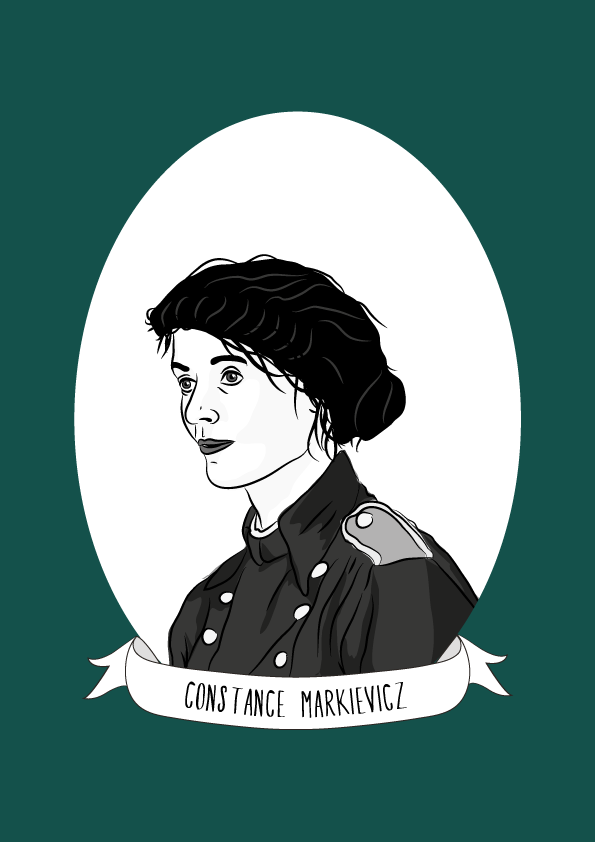Constance Markievicz, known as Countess Markievicz was an Irish Sinn Féin and Fianna Fáil politician, revolutionary nationalist, suffragette and socialist. She was both the first woman elected to the British Parliament and the only woman to serve in the first Dáil Éireann (Irish Assembly).
Markievicz was born in 1868 and grew up at Lissadell, her family’s estate in County Sligo, Ireland. She began her education at home, and in 1893 travelled to London to study art at the Slade School as only one art school in Dublin accepted female students at the time. While there, she joined the National Union of Women’s Suffrage Societies (NUWSS) and began to become politically active. She then continued her studies at the Académie Julian in Paris where she met Count Casmir Dunin Markievicz. They married in 1901, following the death of his first wife.
In 1903, the couple moved to Dublin where Markievicz became known as a landscape artist. Two years later, she founded the United Artists Club to bring together Dublin artists including Sarah Purser, Nathaniel Hone, Walter Osborne and John Butler Yeats. In 1906, Markievicz became inspired by copies of The Peasant and Sinn Féin which had been left at a cottage in the countryside by the poet Padraic Colum. She became involved with Irish nationalists, and joined the revolutionary women’s group Inghinidhe na hÉireann (Daughters of Ireland) and the Sinn Féin political party. In 1909, she formed Na Fianna Éireann (Soldiers of Ireland), a republican organisation which trained young boys to be nationalist soldiers in preparation for a war of liberation.
In 1911, Markievicz was arrested for the first time while demonstrating at an Irish Republican Brotherhood protest against King George V’s visit to Ireland. Her political activism would lead to her arrest and imprisonment on many occasions. In 1913, she worked with labour leaders James Connolly and James Larkin both helping to organise and train the Irish Citizen Army to defend demonstrating workers from the police and in running a soup kitchen at Liberty Hall during the labour dispute in which thousands of people were locked out of their workplaces for refusing to reject union membership.
In 1916, Markievicz was second-in-command to Michael Mallin at St. Stephen’s Green during the Easter Rising, a republican insurrection in Dublin against British government in Ireland. Upon surrendering, she kissed her revolver before handing it over to the British officer. Many women were later arrested, although Markievicz was the only one to be court-martialled. She declared “”I did what I thought was right, and I stand by it” and was initially sentenced to “death by being shot” but her sentence was commuted to lifetime imprisonment due to her sex. She served 13 months in prison, before her release in 1917. A year later, she became the first woman elected to the House of Commons but did not take her seat in line with Sinn Fein’s abstentionist policy. The Irish republicans then set up their own provisional government, Dáil Éireann under the leadership of Eamon de Valera. Markievicz served as the minister of labour from 1919 to 1922. She was both the first Irish female Cabinet Minister and at the same time, only the second female government minister in Europe.
Markievicz left government in 1922 in opposition to the Anglo-Irish Treaty, and fought for the Republican cause in the Irish Civil War helping to defend Moran’s Hotel in Dublin. In 1926, she joined the Fianna Fáil party led by Eamonn de Valera, and was re-elected to the Dáil Éireann but died before she could take up her seat. She is honoured with a limestone bust in St Stephen’s Green, a plaque in St Ultan’s Hospital, a football ground and in WB Yeats’s poem ‘In memory of Eva Gore-Booth and Constance Markievicz’.
